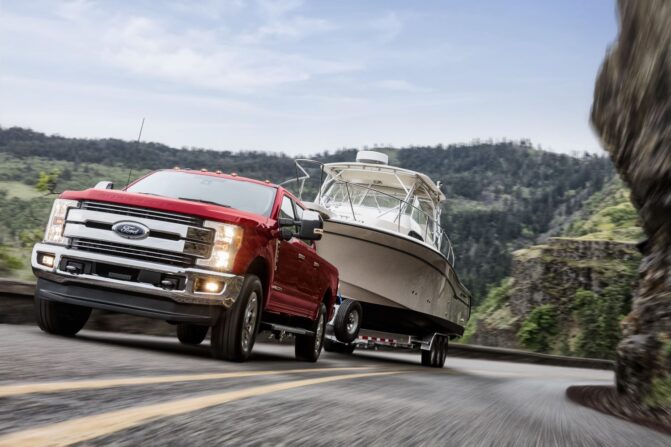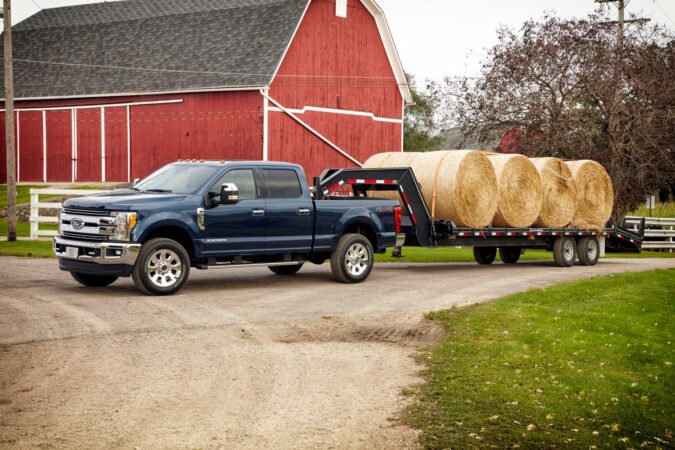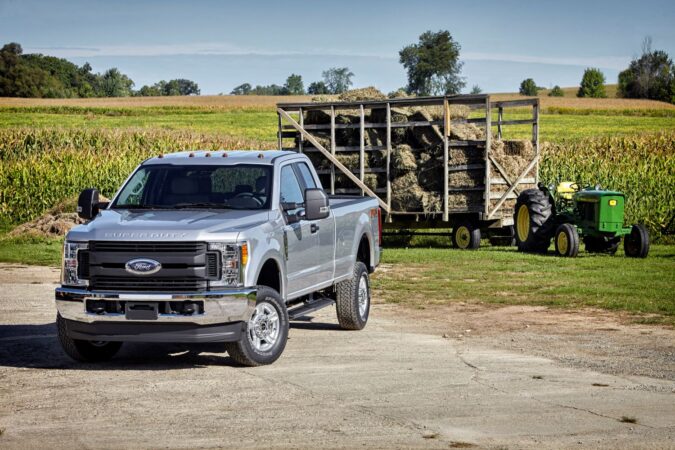By far and away the most popular full-size, large cab pickup truck, particularly in the blue-collar world, is Ford’s Super Duty F250. As a work truck, it’s among the most powerful and capable trucks you can buy today, with enormous payload and towing capacity, and a huge bed. But, one other consideration most folks don’t often think about is the Ford F250 and its gas mileage.
If you’re planning to drive a Ford F250 as a work truck, you’d rather not have to spend massively on fuel bills. This is especially given the incredibly potent and fuel-hungry powertrains that Ford pairs with the F250. This includes a 6.2-liter V8, the oh-so-popular and iconic 6.7-liter “Power Stroke” turbo-diesel V8, and a new 7.3-liter gasoline V8 engine.
Unfortunately, if you’re hoping to not have to fill up too often, the Ford Super Duty F250 is a fuel hog. On average, you’re going to have to get used to 15-ish MPG (depending on which engine you choose). At worst, you might just barely get by with double-digit MPGs. To get a better idea of how much fuel it consumes, here’s how bad the Ford F250 gas mileage is…
What Is The Average Ford F250 Gas Mileage?
The Ford F250 Super Duty has an average in-city driving of 14.6 mpg in stop-and-go traffic. On the highway, the F250 averaged 15.5 mpg. At the end of the trip, the full 48-gallon fuel tank can burn 12.75 gallons of fuel. This can contribute to a 15.7 mpg of combined mileage.
The below table includes community-sourced and owner-submitted fuel economy data amongst owners of the Ford F250 Super Duty, according to Fuelly.com:
| Ford F-250 Super Duty Gas Mileage | |||||
|---|---|---|---|---|---|
| 6.2L Flex Fuel V8 | 6.7L V8 Turbo Diesel | 7.3L V8 Gas Engine | |||
| Model Year(s) | Average Fuel Economy (MPG) | Model Year(s) | Average Fuel Economy (MPG) | Model Year(s) | Average Fuel Economy (MPG) |
| 2021 | 12.1 | 2023 | 15.3 | 2023 | 11.8 |
| 2020 | 11.8 | 2022 | 19.0 | 2022 | 11.1 |
| 2019 | 11.5 | 2021 | 15.5 | 2021 | 11.3 |
| 2018 | 12.1 | 2020 | 15.1 | 2020 | 11.6 |
| 2017 | 12.0 | 2019 | 14.2 | – | – |
| 2016 | 11.4 | 2018 | 13.9 | – | – |
| 2015 | 11.2 | 2017 | 14.4 | – | – |
| 2014 | 11.3 | 2016 | 14.2 | – | – |
| 2013 | 11.1 | 2015 | 14.5 | – | – |
| 2012 | 12.5 | 2014 | 14.1 | – | – |
| 2011 | 10.9 | 2013 | 14.3 | – | – |
| – | – | 2012 | 14.4 | – | – |
| – | – | 2011 | 14.5 | – | – |
How Does The Ford F250 Mileage Compare vs Other Trucks?
Just to give you a better idea of how the Ford F250 and its average gas mileage figures compare with its rivals (some are better, some are worse), here’s how its competitors fare:
- RAM 2500 – RAM 2500, a competitor to the Ford F250, features a standard 6.4-liter V-8 engine, delivering up to 410 horsepower and 429 foot-pounds of torque, with a combined fuel economy rating of 15 MPG. The optional 6.7-liter Cummings diesel engine offers 370 horsepower and 850 foot-pounds of torque.
- Chevy Silverado 2500 HD – The Chevy Silverado 2500 HD comes with a standard 6.6L V8 engine, providing 17 MPG in the city and 19 MPG on the highway. Despite its higher fuel economy, the Chevy 2500 offers a lower maximum towing capacity, peaking at 18,510 lbs, compared to the Ford F250’s range of 14,400 to 26,700 lbs.
- GMC Sierra 2500 HD – Another worthy competitor is the GMC Sierra 2500 HD. Despite having a smaller 6.0-liter V8 engine, its fuel economy does not surpass that of the Ford F250. Offering only about 13 MPG, the GMC Sierra 2500 also has a lower towing capacity, underscoring the fact that smaller engines do not necessarily translate to better fuel economy.
Also, just for comparison’s sake, the Ford F250 Super Duty’s smaller sibling, the F-150, could manage upwards of 20 mpg in the city and 26 mpg. This is with the 2WD and V6 configuration. Otherwise, the 5.0-liter V8 version expects 17 mpg city and 24 mpg highway. Meanwhile, the Ford F-150 hybrid provides 25 mpg in both city and highway driving.
What’s Causing Poor Gas Mileage On Your Ford F250?
The Ford F250 Super Duty’s gas mileage isn’t good, but by comparison with its rivals, it’s not too terrible, either. With that being said, if you’re noticing poorer-than-usual gas mileage, it may not necessarily be Ford’s fault. Here are some external reasons why you might be noticing pretty bad MPGs out of your Ford F250:
1. Dirty Oxygen (O2) Sensor
An oxygen (O2) sensor measures exactly how rich or lean the exhaust gases are when they leave the combustion chamber. This data is then used by the vehicle’s computer to adjust the amount of fuel entering the engine. If the sensor is dirty or failing it can lead to a drop in miles per gallon. It can also lead to failed emission tests and a rough idle.
2. Dirty Fuel Injectors
Fuel injectors spray fuel into the cylinders where it is mixed with air and ignited. Over time the fuel injector system can become clogged. This can lead to a drop in fuel efficiency as well as slow acceleration and the car not having enough power. If caught early, simply cleaning the injectors can solve the problem. As it progresses, the injectors may have to be replaced.
3. Worn Or Dirty Spark Plugs
Spark plugs ignite the fuel in the combustion chamber. If they are dirty or working incorrectly, it can cause the engine to misfire, leading to poor engine performance. This can lead to a lack of power as well as a big decline in fuel efficiency. Remember to replace your spark plugs regularly, whenever the replacement interval is due.
4. Bad Mass Airflow (MAF) Sensor
A mass airflow (MAF) sensor detects the amount of air coming into the combustion chamber. It delivers those readings to the vehicle’s computer, which crunches the numbers and then delivers the proper amount of fuel to the air in the engine. A dirty airflow sensor will degrade fuel efficiency and lead to a rough idle and even engine stalling.
5. Poor Tire/Wheel Alignment
Tires that have low pressure or are out of alignment can lead to a drop in fuel efficiency. This is due to flatter tires and bad tire/wheel alignment causing increased rolling resistance. In other words, your truck isn’t moving as smoothly or as efficiently. Checking the tire pressure and having the alignment checked regularly can help prevent this problem.
6. Defective Fuel Pump
Fuel delivery issues can drastically affect fuel efficiency. The fuel pump pulls the fuel from the gas tank to the fuel injectors. The fuel pump can become clogged or malfunction. A bad fuel pump can lead to a rough-running engine because it is not getting enough fuel. This will lead to a decline in gas mileage. It could also lead to rough idle, sputtering, and stalling.
7. Clogged Fuel Filter
A clogged fuel filter will also cause problems with your Ford F250 Super Duty’s gas mileage. The fuel filter screens out contaminants in the fuel, and over time it will become clogged. Fuel filters need to be replaced periodically. A clogged fuel filter will impact the amount of fuel going into your engine. Thus, causing performance issues and poorer MPGs.



